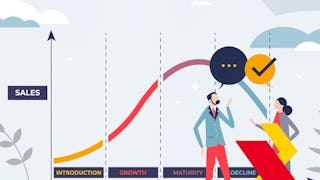This course provides a comprehensive overview of lean portfolio and product management, focusing on transforming business models through customer-centric approaches and innovative product development strategies.
Key topics covered: CUSTOMER ARCHITECTURE The course begins by emphasizing the importance of developing a deep customer-centric perspective. It introduces various frameworks and methodologies to understand and segment customers effectively: - Jobs to be Done (JTBD) framework: This approach helps identify the core needs and motivations of customers, focusing on what they're trying to accomplish rather than just their demographic characteristics. - Customer segmentation: Techniques to categorize customers based on their needs, behaviors, and characteristics. - Customer experience mapping: Creating detailed journey maps to understand how customers interact with products across a portfolio. PRODUCT MARKET FIT A significant portion of the course is dedicated to achieving and measuring product-market fit: - Value Proposition Canvas: A tool to align product offerings with customer needs and desires. - Minimum Viable Product (MVP): Strategies for creating and testing initial product versions to validate market demand. - Metrics for measuring fit: Including Net Promoter Score (NPS), customer retention rates, and customer lifetime value. INNOVATION MODELS The course covers various innovation models and strategies to foster continuous improvement and product development: - Design Thinking: A human-centric approach to problem-solving and innovation. - Lean Startup: Methodology for rapid experimentation and iterative product development. - Blue Ocean Strategy: Focusing on creating uncontested market spaces rather than competing in existing markets. - Three Horizons Model: Balancing current business needs with future growth opportunities. PRODUCT ARCHITECTURE The course delves into product architecture, emphasizing the importance of modular design and scalability: - Component model: Understanding products as a sum of interconnected, standardized parts. Plug-and-play architecture: Designing products for easy integration and expansion. - Internal platforms: Building scalable foundations for multiple products within a portfolio. BUSINESS MODEL INNOVATION Students learn about various ways to innovate not just in product features, but in how businesses deliver value and generate revenue: - Freemium models: Offering basic services for free while charging for premium features. - Subscription-based models: Shifting from one-time purchases to recurring revenue streams. - Direct-to-consumer sales: Eliminating intermediaries in the sales process. PORTFOLIO MANAGEMENT The course provides insights into managing a collection of products effectively: - Balanced portfolio framework: Balancing quick wins, core improvements, and big bets. - Feature gap analysis: Identifying unmet customer needs across product lines. - Cross-product synergies: Leveraging strengths across different products in a portfolio. METRICS AND KPIS Throughout the course, there's a strong emphasis on measuring success and driving improvements: - Objectives and Key Results (OKRs): A framework for setting and tracking goals. - Key Performance Indicators (KPIs): Metrics to measure product and portfolio performance. - Customer satisfaction metrics: Including CSAT, NPS, and customer effort score. INNOVATION CULTURE AND PROCESSES The course discusses how to foster a culture of innovation within organizations: - Collaborative culture: Encouraging cross-functional teamwork and idea sharing. - Empowerment: Giving teams the freedom and resources to innovate. - Risk tolerance: Balancing the need for innovation with responsible risk management. BUSINESS MODEL CANVAS Students learn to use the Business Model Canvas as a tool for visualizing and developing business models for new and existing products: - Nine key components: Including value propositions, customer segments, revenue streams, and cost structure. - Feasibility, desirability, and viability: The three key areas to evaluate business model strength. REVENUE MODELS The course explores various revenue models that can be applied to products: - Transactional models: One-time purchases, licensing, and royalties. - Recurring revenue models: Subscriptions and software-as-a-service (SaaS). - Platform models: Advertising, data monetization, and transaction fees. PRACTICAL APPLICATION Throughout the course, real-world case studies and examples are used to illustrate concepts, along with knowledge checks to test you on the lessons. - Netflix Kids case study: Demonstrating how to launch a differentiated portfolio offering. - Automotive industry examples: Showing how lean manufacturing and modular design principles are applied. This course is designed for product managers, business strategists, and entrepreneurs looking to develop innovative, customer-centric products and manage diverse product portfolios. It combines theoretical frameworks with practical applications, providing students with the tools to transform business models and drive growth through effective product management strategies.

















